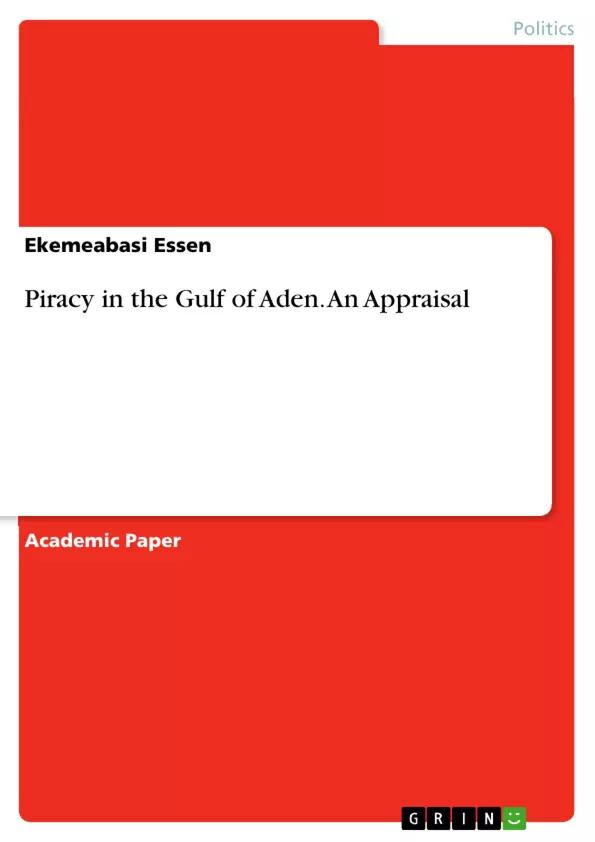Imagine a world where vital sea lanes, the jugular veins of global commerce, are threatened by modern-day marauders. This book plunges into the heart of maritime piracy in the Gulf of Aden, a critical chokepoint connecting Europe and Asia, exploring the complex web of factors that have transformed this region into a hotbed of illicit activity. Uncover the historical roots of Somali piracy, tracing its evolution from localized incidents to a sophisticated, internationally recognized threat jeopardizing maritime security. Delve into the socio-economic conditions, political instability, and governance challenges that fuel piracy, and examine the devastating consequences for international trade, regional stability, and the seafarers caught in the crossfire. Critically assessing the existing legal frameworks at local, regional, and international levels, this study exposes the gaps and ambiguities that hinder effective counter-piracy efforts, particularly the limitations of the United Nations Convention on the Law of the Sea (UNCLOS) in addressing modern piracy scenarios. From analyzing the definition of piracy and its application in complex situations like the Achille Lauro incident to evaluating the effectiveness of current counter-piracy strategies, this book leaves no stone unturned. Furthermore, it meticulously examines the roles and responsibilities of various international institutions and regional actors involved in combating piracy, highlighting the challenges of coordination and cooperation. Finally, this incisive analysis offers concrete, actionable recommendations for mitigating piracy in the Gulf of Aden, advocating for a multi-faceted approach that combines robust law enforcement, enhanced maritime security measures, and sustainable development initiatives to address the root causes of this persistent threat, ensuring safer passage for international shipping and promoting lasting stability in this strategically vital region. Explore the depths of maritime piracy, understand its implications, and discover potential pathways towards a more secure and prosperous future for the Gulf of Aden and beyond, including the study of international law, legal frameworks, maritime security, counter-piracy measures, and regional and international cooperation.
Inhaltsverzeichnis (Table of Contents)
- Abstract
- Introduction
- Conceptual Framework
- Piracy
- Maritime Security
- Gulf of Aden
- Somalia
- Research Question
- Background of Study
- Consequences of Piracy in the Gulf of Aden
- Legal Framework for Combating Piracy in the Gulf of Aden
- Local/National Level
- Regional Level
- International Level
- Institutions for Combating Piracy in the Gulf of Aden
- Challenges
- Conclusion
- Recommendations
Zielsetzung und Themenschwerpunkte (Objectives and Key Themes)
This paper assesses piracy in the Gulf of Aden, examining its background and analyzing the contributing factors to propose mitigation measures. It utilizes a doctrinal research methodology, employing case laws, legal textbooks, and other legal sources. The study aims to understand the causes of piracy and suggest solutions.
- The history and rise of piracy in the Gulf of Aden.
- Analysis of the factors and causes contributing to piracy in the region.
- Examination of the consequences of piracy on regional and global scales.
- Evaluation of the legal frameworks at local, regional, and international levels in combating piracy.
- Proposing solutions and recommendations for mitigating piracy in the Gulf of Aden.
Zusammenfassung der Kapitel (Chapter Summaries)
Introduction: This chapter introduces the escalating problem of piracy in the Gulf of Aden, highlighting its strategic location as a crucial shipping lane connecting Europe and Asia. It emphasizes the economic significance of this waterway, carrying substantial amounts of petroleum and goods, and the rich marine resources that further attract pirate activity. The chapter sets the stage by illustrating the global concern and the efforts undertaken by both the international community and coastal states to tackle this issue. The historical context is briefly touched upon, showcasing the emergence of modern maritime piracy off the coast of Somalia during the 1990s and early 2000s.
Conceptual Framework: This section defines piracy, drawing from the United Nations Convention on the Law of the Sea (UNCLOS). However, it critically analyzes the limitations of this definition, specifically highlighting its geographical restrictions and the ambiguity regarding “private ends” and the involvement of only two ships. The insufficiency of UNCLOS in addressing instances of piracy occurring within straits, ports, or internal seizures of ships is highlighted. The chapter uses the Achille Lauro incident as a case study to illustrate the shortcomings of the UNCLOS definition.
Schlüsselwörter (Keywords)
Piracy, Maritime Security, Gulf of Aden, Somalia, International Law, Legal Framework, Maritime Piracy, Counter-Piracy, Regional Cooperation, International Cooperation.
Häufig gestellte Fragen
Was ist das Hauptthema dieses Dokuments?
Das Dokument bietet eine umfassende Sprachvorschau eines Forschungsdokuments über Piraterie im Golf von Aden. Es enthält das Inhaltsverzeichnis, Zielsetzungen, Themenschwerpunkte, Kapitelzusammenfassungen und Schlüsselwörter.
Welche Themen werden im Inhaltsverzeichnis aufgeführt?
Das Inhaltsverzeichnis umfasst Themen wie Abstract, Einleitung, konzeptioneller Rahmen (Piraterie, maritime Sicherheit, Golf von Aden, Somalia), Forschungsfrage, Hintergrund der Studie, Folgen der Piraterie, rechtlicher Rahmen zur Bekämpfung der Piraterie auf lokaler, regionaler und internationaler Ebene, Institutionen zur Bekämpfung der Piraterie, Herausforderungen, Schlussfolgerung und Empfehlungen.
Welche Ziele und Themenschwerpunkte werden in dem Dokument genannt?
Das Papier beurteilt die Piraterie im Golf von Aden, untersucht den Hintergrund und analysiert die beitragenden Faktoren, um Maßnahmen zur Eindämmung vorzuschlagen. Es werden die Geschichte und der Aufstieg der Piraterie, die Faktoren und Ursachen, die Folgen der Piraterie, die rechtlichen Rahmenbedingungen und Lösungsansätze untersucht.
Was wird in der Zusammenfassung des Kapitels "Einleitung" behandelt?
Die Einleitung behandelt das eskalierende Problem der Piraterie im Golf von Aden, betont die strategische Lage als wichtige Schifffahrtsstraße und hebt die wirtschaftliche Bedeutung dieses Wasserweges hervor.
Was wird im Abschnitt "Konzeptioneller Rahmen" analysiert?
Dieser Abschnitt definiert Piraterie basierend auf dem Seerechtsübereinkommen der Vereinten Nationen (UNCLOS) und analysiert kritisch die Einschränkungen dieser Definition, insbesondere geografische Beschränkungen und die Mehrdeutigkeit in Bezug auf "private Zwecke" und die Beteiligung von nur zwei Schiffen.
Welche Schlüsselwörter werden im Dokument genannt?
Die Schlüsselwörter umfassen Piraterie, maritime Sicherheit, Golf von Aden, Somalia, internationales Recht, rechtlicher Rahmen, maritime Piraterie, Pirateriebekämpfung, regionale Zusammenarbeit, internationale Zusammenarbeit.
- Citar trabajo
- Ekemeabasi Essen (Autor), 2021, Piracy in the Gulf of Aden. An Appraisal, Múnich, GRIN Verlag, https://www.grin.com/document/1023419



